1998 GMC SIERRA check engine
[x] Cancel search: check enginePage 325 of 452
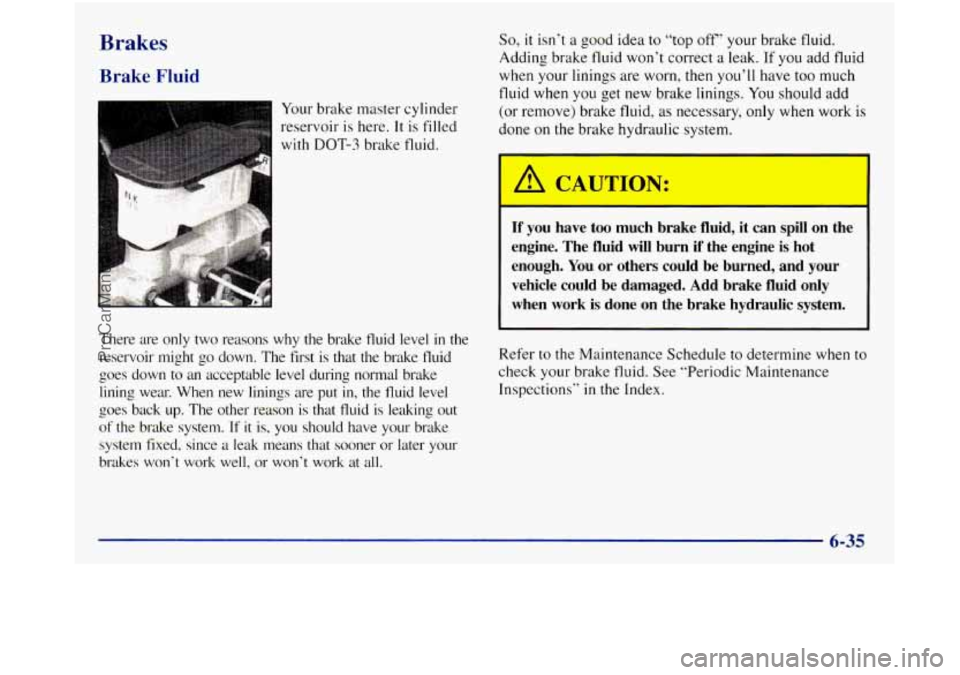
Brakes
Brake Fluid
Your brake master cylinder
reservoir is here. It
is filled
with DOT-3 brake fluid.
There are only two reasons why the brake fluid level
in the
reservoir might go down. The first is that the brake fluid
goes down to an acceptable level during normal brake
lining wear. When new linings are put
in, the fluid level
goes back up. The other reason is that fluid
is leaking out
of the brake system. If it is, you should have your brake
system fixed, since
a leak means that sooner or later your
brakes won’t work well, or won’t work at
all.
So, it isn’t a good idea to “top off’ your brake fluid.
Adding brake fluid won’t correct a leak.
If you add fluid
when your linings are worn, then you’ll
have too much
fluid when
you get new brake linings. You should add
(or remove) brake fluid,
as necessary, only when work is
done
on the brake hydraulic system.
- - -
4 CAU-ION:
If you have too much brake fluid, it can spill on the
engine. The fluid
will burn if the engine is hot
enough. You or others could be burned, and your
vehicle could be damaged. Add brake fluid only when
work is done on the brake hydraulic system.
Refer to the Maintenance Schedule to determine when to
check your brake fluid. See “Periodic Maintenance
Inspections” in the Index.
6-35
ProCarManuals.com
Page 360 of 452

Vehicle IdentiP ’* -In N mber (VIN)
- =I I1 11111111 1111 11111111t 111 111111 II 111111111111 111111111 II
ENGINE A98 f ASSEMBLY
CODE- MODEL YEAR PLANT
This is the legal identifier for your vehicle. It appears on
a plate in the front corner
of the instrument panel, on the
driver’s side.
You can see it if you look through the
windshield from outside your vehicle. The VIN also
appears on
the Vehicle Certification and Service Parts
labels and the certificates
of title and registration.
Engine Identification
The 8th character in your VIN is the engine code. This
code will help you identify your engine, specifications
and replacement parts.
Service Parts Identification Label
You’ll find this label on the inside of the glove box. It’s
very helpful if
you ever need to order parts. On this
label is:
your VIN,
the model designation,
0 paint information and
0 a list of all production options and special
Be sure that this label is not removed from the vehicle.
equipment.
Electrical System
Add-on Electrical Equipment
1 NOTICE:
Don’t add anything electrical to your vehicle
unless you check with your dealer first. Some
electrical equipment can damage your vehicle
and the damage wouldn’t be covered
by your
warranty. Some add-on electrical equipment
can keep other components from working as
they should.
Your vehicle has an air bag system. Before attempting to
add anything electrical to your vehicle, see “Servicing
Your Air Bag-Equipped Vehicle”
in the Index.
6-70
ProCarManuals.com
Page 364 of 452

Fuse/Circuit Breaker Usage
20
21
22
23
24
A
B
PRNDL, Automatic Transmission,
Speedometer, Check Gages
Warning Light
Security/Steering
Not Used
Not Used
Front Axle,
4WD Indicator Lamp,
TP2 Relay (Gasoline Engine)
Power Door Lock, Six-Way Power Seat, Keyless Entry Module
Power Windows
Underhood Fuse/Relay Center
The underhood fusehelay center is located in the rear of
the engine compartment near the brake fluid reservoir.
Move the retainer clips
for the cover to access the
fuse block.
You can remove fuses with a fuse extractor. The fuse
extractor
is mounted to the interior fuse block. TO
remove fuses
if you don’t have a fuse extractor, hold the
end of the fuse between your thumb and index finger
and pull straight out.
6-74
ProCarManuals.com
Page 369 of 452
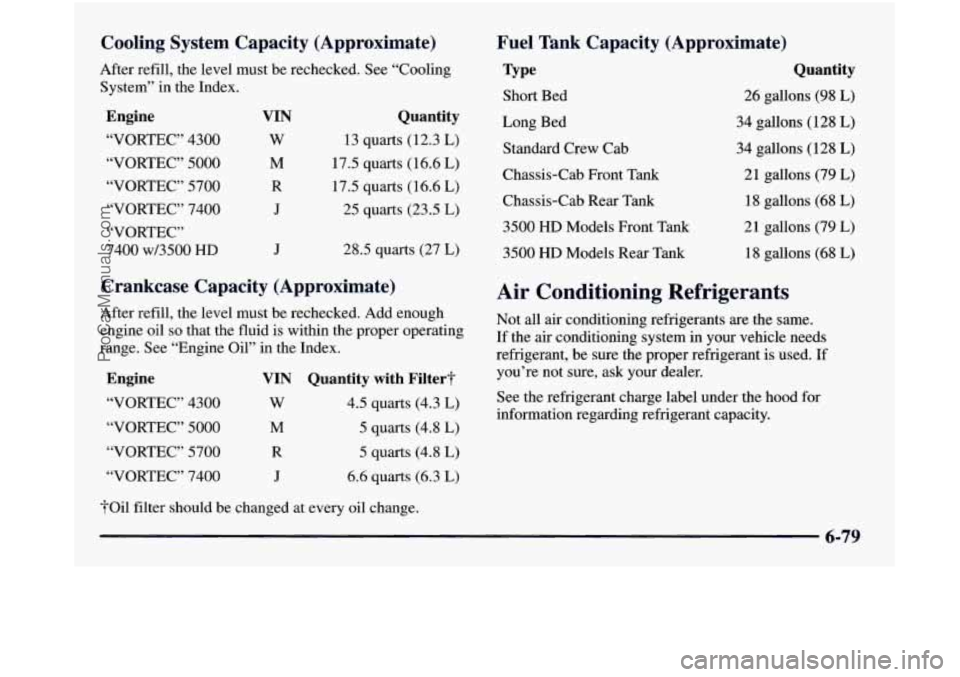
Cooling System Capacity (Approximate)
After refill, the level must be rechecked. See “Cooling
System” in the Index.
Engine
“VORTEC” 4300
“VORTEC” 5000
“VORTEC” 5700
“VORTEC” 7400
“VORTEC”
7400 w/3500 HD
VLN
w
M
R
J
J
Quantity
13 quarts (12.3 L)
17.5 quarts (16.6 L)
17.5 quarts (16.6
L)
25 quarts (23.5 L)
28.5 quarts (27
L)
Crankcase Capacity (Approximate)
After refill, the level must be rechecked. Add enough
engine oil
so that the fluid is within the proper operating
range. See “Engine Oil” in the Index.
Engine
“VORTEC” 4300
“VORTEC” 5000
“VORTEC” 5700
“VORTEC” 7400
VIN Quantity with Filter?
w 4.5 quarts (4.3 L)
M 5 quarts (4.8 L)
R 5 quarts (4.8 L)
J 6.6 quarts (6.3 L)
foil filter should be changed at every oil change.
Fuel Tank Capacity (Approximate)
PPe Quantity
Short Bed
26 gallons (98 L)
Long Bed
34 gallons (128
L)
Standard Crew Cab 34 gallons (128 L)
Chassis-Cab Front Tank 2 1 gallons (79 L)
Chassis-Cab Rear Tank
18 gallons (68
L)
3500 HD Models Front Tank
21 gallons (79 L)
3500 HD Models Rear Tank
18 gallons (68
L)
Air Conditioning Refrigerants
Not all air conditioning refrigerants are the same.
If the air conditioning system in your vehicle needs
refrigerant, be sure the proper refrigerant is used. If
you’re not sure, ask your dealer.
See the refrigerant charge label under the
hood for
information regarding refrigerant capacity.
6-79
ProCarManuals.com
Page 374 of 452
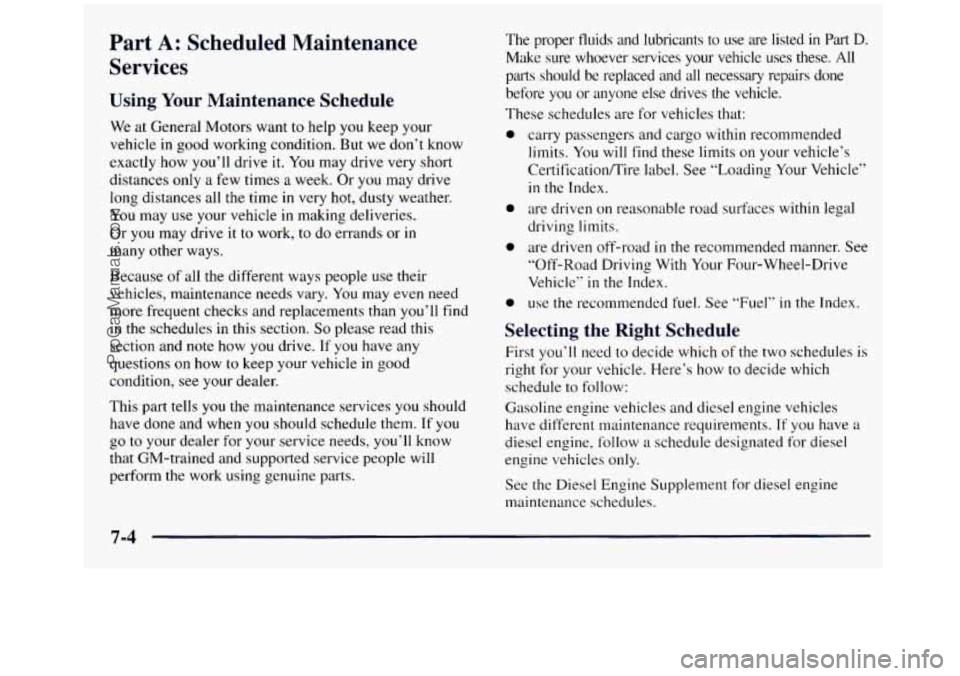
Part A: Scheduled Maintenance
Services
Using Your Maintenance Schedule
We at General Motors want to help you keep your
vehicle
in good working condition. But we don't know
exactly how you'll drive it. You may drive very short
distances only
a few times a week. Or you may drive
long distances all
the time in very hot, dusty weather.
You may use your vehicle in making deliveries.
Or
you may drive it to work, to do errands or in
many other ways.
Because of all the different ways people use their
vehicles, maintenance needs vary. You may even need
more frequent checks and replacements than you'll find
in the schedules in this section.
So please read this
section and note how
you drive. If you have any
questions
on how to keep your vehicle in good
condition, see your dealer.
This part tells
you the maintenance services you should
have done and when you should schedule them. If you
go to your dealer for your service needs, you'll know
that GM-trained and supported service people
will
perform the work using genuine parts. The proper fluids and lubricants to use are listed
in Part D.
Make sure whoever services your vehicle uses these. All
pats
should be replaced and all necessary repairs done
before you or anyone else drives the vehicle.
These schedules are for vehicles that:
0 carry passengers and cargo within recommended
limits, You
will find these limits on your vehicle's
Certification/Tire label. See "Loading Your Vehicle"
in the Index.
0 are driven on reasonable road surfaces within legal
driving limits.
0 are driven off-road in the recommended manner. See
"Off-Road Driving With Your Four-Wheel-Drive
Vehicle"
in the Index.
0 use the recommended fuel. See "Fuel" in the Index.
Selecting the Right Schedule
First you'll need to decide which of the two schedules is
right for your vehicle. Here's how to decide which
schedule
to follow:
Gasoline engine vehicles and diesel engine vehicles
have different maintenance requirements.
If you have a
diesel engine, follow a schedule designated for diesel
engine vehicles only.
See the Diesel Engine Supplement for diesel engine
maintenance schedules.
7-4
ProCarManuals.com
Page 378 of 452
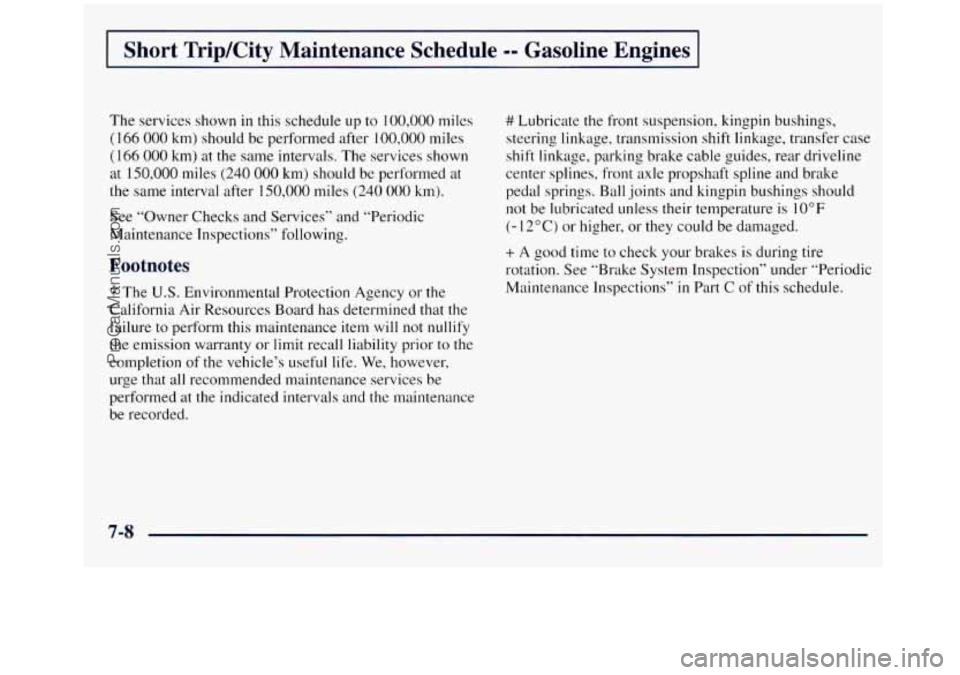
I Short Trip/City Maintenance Schedule -- Gasoline Engines I
The services shown in this schedule up to 100,000 miles
(I 66 000 km) should be performed after 100,000 miles
(166 000 km) at the same intervals. The services shown
at 150,000 miles (240 000 km) should be performed at
the same interval after
150,000 miles (240 000 km).
See “Owner Checks and Services” and ”Periodic
Maintenance Inspections” following.
Footnotes
p The U.S. Environmental Protection Agency or the
California Air Resources Board has determined that the
failure to perform this maintenance item will not
nullify
the emission warranty or limit recall liability prior to the
completion of the vehicle’s useful life. We, however,
urge that all recommended maintenance services be
performed
at the indicated intervals and the maintenance
be recorded.
# Lubricate the front suspension, kingpin bushings,
steering linkage. transmission shift linkage, transfer case
shift linkage, parking brake cable guides, rear driveline
center splines, front axle propshaft spline and brake
pedal springs. Ball joints and kingpin bushings should
not be lubricated unless their temperature is 10°F
(- 12°C) or higher, or they could be damaged.
+ A good time to check your brakes is during tire
rotation. See ”Brake System Inspection’’ under “Periodic
Maintenance Inspections”
in Part C of this schedule.
7-8
ProCarManuals.com
Page 379 of 452

1 Short Trip/City Maintenance Schedule -- Gasoline Engines I
4:::: Drive axle service (see "Recommended Fluids and
Lubricants"
in the Index for proper lubricant to use):
0 Locking Differential -- Drain fluid and refill at first
engine oil change. At subsequent oil changes, check
fluid level and add fluid as needed.
If driving in
dusty areas or towing a trailer, drain fluid and refill
every
15,000 miles (25 000 km).
Standard Differential -- Check fluid level and add
fluid as needed at every oil change.
If driving in
dusty areas or towing a trailer. drain fluid and refill
every 15,000 miles (25
000 km).
More frequent lubrication may be required for
0 3500 HD Models with applications requiring
heavy-duty
or off-road use.
extreme overload/trailer towing conditions and
high-speed (above
45 mph or 70 km/h) conditions
for extended periods of time must have the drive axle
fluid changed every
30,000 miles (50 000 km).
See "Recommended Fluids and Lubricants" in
this section.
7-9
ProCarManuals.com
Page 380 of 452
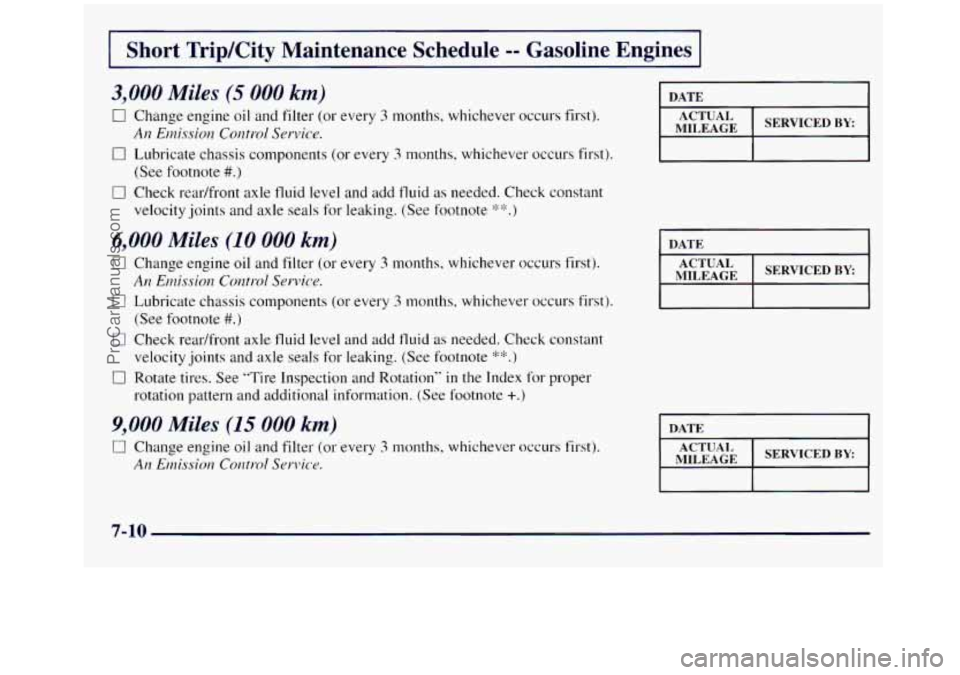
I Short TripKity Maintenance Schedule -- Gasoline Engines I
3,000 Miles (5 000 km)
Ci Change engine oil and filter (or every 3 months, whichever occurs first).
0 Lubricate chassis components (or every 3 months, whichever occurs first).
0 Check readfront axle fluid level and add fluid as needed. Check constant
An Etnission Comd Service.
(See footnote #.)
velocity joints and axle seals for leaking. (See footnote $'*.)
6,000 Miles (10 000 km)
Cl Change engine oil and filter (or every 3 months, whichever occurs first).
0 Lubricate chassis components (or every 3 months, whichever occurs first).
0 Check readfront axle fluid level and add fluid as needed. Check constant
0 Rotate tires. See "Tire Inspection and Rotation" in the Index for proper
An Emission Colztr-ol Service.
(See footnote #.)
velocity joints and axle seals for leaking. (See footnote **.)
rotation pattern and additional information. (See footnote +.)
9,000 Miles (15 000 km)
0 Change engine oil and filter (or every 3 months, whichever occurs first).
An EInisston Control Service.
I DATE I
I MILEAGE ACT I SERVICEDBY I
DATE
MILEAGE
DATE I
SERVICED BY
7-10
ProCarManuals.com